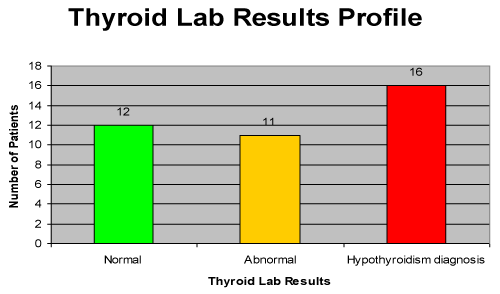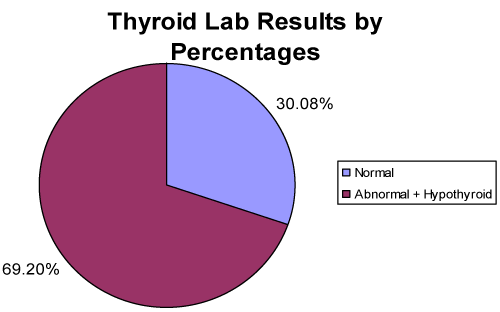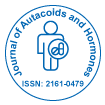Research Article Open Access
Effects of 5HT2c Blockade of Dibenzodiazepines on Thyroid Levels in Patients with Schizophrenia or Schizoaffective Disorder
| Shankar GS1 * and Carol Yuan2 | ||
| 1Associate Professor of Pharmacy, Clinical Psychopharmacology, Western University of Health Sciences, CA 91766, USA | ||
| 2Clinical Assistant Professor of Pharmacy Practice-Ambulatory Care in Psychiatric Pharmacotherapy and Pharmacy Director, Aurora Charter Oak Behavioral Health, Covina, CA, USA | ||
| Corresponding Author : | Shankar GS Associate Professor of Pharmacy, Clinical Psychopharmacology Western University of Health Sciences, CA 91766, USA E-mail: GShankar@westernu.edu |
|
| Received February 12, 2013; Accepted June 12, 2013; Published June 14, 2013 | ||
| Citation: Shankar GS, Yuan C (2013) Effects of 5HT2c Blockade of Dibenzodiazepines on Thyroid Levels in Patients with Schizophrenia or Schizoaffective Disorder. Autacoids 2:102. doi: 10.4172/2161-0479.1000102 | ||
| Copyright: © 2013 Shankar GS, et al. This is an open-access article distributed under the terms of the Creative Commons Attribution License, which permits unrestricted use, distribution, and reproduction in any medium, provided the original author and source are credited. | ||
Related article at Pubmed Pubmed  Scholar Google Scholar Google |
||
Visit for more related articles at Journal of Autacoids and Hormones
Abstract
Drug-induced hypothyroidism has been often observed with the use of lithium in patients with mental disorders. However, atypical antipsychotic medications, especially those with serotonin 2c (5HT2c) blockade like dibenzodiazepines have not been examined for their association with the occurrence of subclinical hypothyroidism. Atypical antipsychotic medications are commonly used in patients with psychiatric disorders, specifically in schizophrenia and schizoaffective disorders. The objective of this retrospective case analysis is to examine the thyroid function of patients with schizophrenia or schizoaffective disorder receiving dibenzodiazepines. This study includes patients that are on one or more of these atypical anti-psychotic agents: clozapine, olanzapine, quetiapine. Clinical outcome measured includes the effect on dibenzodiazepines on thyroid function (e.g. TSH, Free T4, and T4).
A total of 42 charts of the patients were included in the study. Out of the 42 patients, 13 had normal thyroid labs, 11 had abnormal thyroid labs, and 18 patients had a diagnosis of hypothyroidism, and currently on a thyroid medication. Therefore, 31% of these patients were found to have normal thyroid levels, while 69% of these patients were found to have either slightly abnormal thyroid indices (subclinical hypothyroidism), or an impairment of thyroid function.
The results of our study show that in patients with schizophrenia or schizoaffective disorder that are on clozapine, olanzapine, quetiapine, or any combination of the four, a higher percentage of them exhibited abnormal thyroid function with subclinical hypothyroidism, or on thyroid supplements. Future studies may be warranted to further evaluate the effect of antipsychotics with 5HT2c blockade on thyroid function.
| Keywords | |
| Schizophrenia; Hypothyroidism; Serotonin; Antipsychotics | |
| Introduction | |
| Hypothyroidism is prevalent at the rate of 0.1-2% in general population. It is seen 10 times more commonly in females than males, especially in postmenopausal women [1]. According to the National Health and Nutrition Examination Survey (NHANES III), hypothyroidism has been found about 4.6% among the total population ofthe United States (0.3% overt and 4.3% subclinical) [2]. Serotonin (5- HT) is a neurotransmitter that plays a cardinal role in the regulation of thought, perception, emotions, anxiety, sleep, stress hormones, and other body functions like satiety and metabolism. Although some studies suggest the interactions between serotonin (5HT) and thyroid axis, very few clinical studies really were conducted in humans about the potential relationship between the serotonin and thyroid function centrally. Cleare et al. [3], in their study noted the depressed 5-HT responsiveness in 7 hypothyroid patients, using cortisol and prolactin responses to the serotonin 5HT2c agonist fenfluramine as indices for central serotonin response. In their study, they observed decreased serotonin activity in hypothyroidism and an inverse relationship between thyrotropin (TSH) and cortisol responses. They also observed a close interaction between the serotonin and hypothalamic- pituitary-thyroid system has been clearly established. It is more or less established the involvement of serotonin (5-HT) in the regulation of the hypothalamic-pituitary-thyroid system [4]. Thyroid hormones, in turn, modulate serotonin synthesis and turnover. Injection of thyroid hormones to rats with hypothyrosis and to euthyroid animals led to an increase of cortical 5-HT concentration [5]. In addition, thyroid hormones modify sensitivity and expression of 5-HT receptors [6]. | |
| Drug induced hypothyroidism has been commonly associated with lithium use in patients with psychiatric disorders, and is well documented in the literature. However, up to date, there have been no studies evaluating atypical antipsychotic agents and their relationship with hypothyroidism.There has been no study up to date assessing the relationship between these three agents and thyroid function. Currently there are no guidelines or recommendations regarding routine thyroid laboratory testing in patients on these medications. This study, based on chart reviews, aims to assess the incidence of abnormal thyroid function lab results or abnormal thyroid function (hypothyroidism in particular) in patients diagnosed with schizophrenia or schizoaffective disorder that are taking these medications, and future controlled studies are needed on this subject. Our study also examines various patient characteristics to see if there is any relationship between those features and thyroid function in this population. In this study, four of the newer generation of antipsychotics, clozapine, olanzapine, quetiapine have been studied, along with thyroid laboratory levels to examine if there is any association between these atypical antipsychotics and thyroid function. | |
| Methods | |
| Design | |
| Retrospective case study using chart reviews. Information from the hospital charts were used for data collection. Informed consent was obtained from the patients and IRB approval was sought and obtained from the IRB of Western University of Health Sciences, Pomona, California, prior to the study. This study was conducted in free standing psychiatric facility, located in Southern California, USA. | |
| Study population | |
| Study includes male and female patients between the ages of 20-65 years old, and is diagnosed with either schizophrenia or schizoaffective disorder. The patients are currently (at the time of study) receiving clozapine, olanzapine and quetiapine, or any combination of these three antipsychotics. Exclusion criteria include: patients that do not have a diagnosis of schizophrenia or schizoaffective disorder, present or past use of lithium, current phenytoin or carbamezapine use in patients with abnormal thyroid lab indices, females over 50 years old, and those without adequate thyroiddata. | |
| Sources of data | |
| The institution’s current inpatient charts were used as the source of data. Patients that met the inclusion criteria were further evaluated for demographics information, such as age, gender, and ethnicity. The charts were also reviewed for medication records, diagnoses and thyroid lab indices. | |
| Data collection | |
| The following demographic information was collected: age (year), gender (female or male), ethnicity (African-American, Asian- American/Pacific Islander, Caucasian, Spanish/Hispanic, other), diagnoses (schizophrenia, schizoaffective disorder, hypothyroidism), patients’ past and current medications, Thyroid indices (TSH, T3, Free T4). The current use of clozapine, olanzapine, quetiapine, risperidone, along with thyroid function was evaluated. | |
| Study medication use was defined as currently being on one or more of the medications at the time of chart review, and prior to the collection of thyroid lab indices. Medication information was collected from patients’ charts. Medications prior to admission to the institution, as well as medications prescribed while at the institution, were looked at. There was no defined length of time examined in this study. However, most patients have been on one or more of these medications, prior to admission to this institution. The dosage of the medications was also not analyzed due to the frequent adjustments made to patients’ medication regimens. In addition to the medications of interest, patients’ other medications were also assessed for any effect on thyroid function. Therefore, the use of lithium, both past and present, was examined, as well as other medications that may affect thyroid laboratory results and excluded from the study. | |
| Thyroid laboratory panel data was collected through the laboratory section of the patients’ charts. The data collected was patients’ TSH levels, T3 levels, and Free T4 levels. All patients’ available thyroid laboratory results were examined from the time of admission to the most current results available. Normal thyroid function results were analyzed through the laboratory’s reference ranges, depending on the laboratory providing the service. Abnormal thyroid function laboratory results in this study are defined by a low Free T4 level, low T3 level, or high TSH level. Therefore, the study only looked at the levels of thyroid function associated with hypothyroidism. However, there has been no abnormally thyroid function lab level associated with hyperthyroidism found in any patient in our study. | |
| Statistical analysis | |
| Descriptive statistics was used for the analysis of data. The descriptive statistics include means and percentages. For the categorical variables, basic descriptive statistic are reported. The chi-square test was used to analyze demographic variables with thyroid function data. | |
| Results | |
| Out of 39 patients that met the inclusion criteria, there were 12 patients with normal thyroid laboratory results, 11 patients with abnormal thyroid laboratory results, but no documented diagnosis of hypothyroidism, and 16 patients with a documented diagnosis of hypothyroidism, and currently on medications for treatment (Figure 1). Finally, 12 out of 39 patients (30.8%) of patients had normal thyroid laboratory results, and 27 out of 39 (69.2%) of patients had abnormal thyroid function (Figure 2). These 11 patients with abnormal thryoid function laboratory results that did not have a documented diagnosis of hypothyroidism, 10 of them had low T4 or free T4 levels with normal TSH levels. Regarding the patients with hypothyroid diagnosis, the cause of their abnormal thyroid function is now reasonably can be predictable (Figure 3). | |
| When categorizing the patients by ethnicity, there was no observed significant difference. In the African-American group, there was 4 out of 9 patients with abnormal thyroid levels, 5 out of 6 patients in the Asian-American/Pacific Islander group, 11 out of 13 in the Caucasian group, and 7 out of 11 in the Spanish/Hispanic group (Table 1). There was also no significant difference observed between males and females. There were 12 out of 14 females with abnormal thyroid labs and 15 out of 25 males with abnormal thyroid lab results. In terms of age, the mean age of the population assessed was 41 years old, with a median age of 43 years old. Among the patients with abnormal thyroid levels, the mean age was 40.59 years old and the median was 43 years old. There was no significant difference observed in the average age of patients with abnormal thyroid versus normal thyroid function lab results (Table 2). | |
| Discussion | |
| In this study, we observed the majority of patients diagnosed with schizophrenia or schizoaffective disorder that were taking either clozapine, olanzapine, quetiapine, or combination of any of the four atypical antipsychotics, had abnormal thyroid function laboratory results.There are some limitations to this study. Since this is a retrospective case study, there was no control group in which to compare these findings to for a statistical significance analysis. There was not enough number of patients in the institution at the time of data collection that were not taking any of the medications of interest. Out of the 92 charts reviewed, there were only 6 patients that could have potentially been assessed for comparison. The difference in the number of patients on these medications that had an abnormal thyroid function level, and those who did not, may suggest a potential possibility of a relationship between these atypical antipsychotics and hypothyroidism, but a direct correlation cannot be drawn from this type of study at this time. | |
| The majority of patients in the study demonstrated abnormal thyroid laboratory results or abnormal thyroid function. However, assessing proportion of these patients who display abnormal results due to the disease state itself could not be determined. Quetiapine ( ± clozapine/olanzapine) was prescribed in 32 of the patients, hence, it is not clear whether the results are primarily due to this agent. The majority of patients with abnormal thyroid laboratory results (without a hypothyroid diagnosis) showed low T4 or Free T4 levels, with normal TSH levels. Therefore, these patients are not considered to have subclinical hypothyroidism. Future studies may be needed to examine the clinical relevance of these results. | |
| Although the exclusion criteria were used to filter out patients characteristics that may contribute to an inaccurate assessment of their thyroid function tests, the precision of the study remained a challenge. Patients that did not have a diagnosis of schizophrenia or schizoaffective disorder were excluded from the study. Patients with a past history of lithium use or were currently taking lithium were also excluded due to its affects on thyroid function. Female patients greater or equal to 50 years of age were also eliminated from data analysis due to the natural trend towards abnormal thyroid function in older women. Patients that had abnormal thyroid function, and had been taking carbamezapine or phenytoin, were also excluded because they can potentially increase T4 clearance and show a low T4 level in the laboratory results. | |
| In this certain study population, it was a challenge to obtain precise data due to the frequent changes in medication regimens, as well as the lack of available data on previous medication history and diagnosis dates for hypothyroidism. Therefore, it is difficult to draw any conclusions from the high number of patients with abnormal thyroid function labotatory readings. There was a lack of collectible data regarding patients time of hypothyroid diagnosis and the medications they were taking at that time. Also, the adjustments made to their medication regimens were frequent, and was not conducive to draw any correlations in regard to duration, dosages, or specific agents. Although there was more than double the number of patients with abnormal thyroid levels than normal levels, a true relationship cannot be drawn without a randomized controlled study with statistical significance. | |
| Although there is no significant conclusion that can be drawn from this study, the general findings contribute to knowledge of the possibility that these atypical antipsychotic agents may have a role in abnormal thyroid function lab results, resulting in hypothyroidism or laboratory values associated with hypothyroidism. Future studies are warranted with more precise measurement of duration of use and dosage strengths. The apparent direct relationship between 5HT2c blockade with atypical antipsychotics and circulating thyroid hormones is really compatible with our observations made in this study. This observation is likely to have clinically significant importance in the clinical outcome of treatment in schizophrenia, schizoaffective disorder and metabolic syndrome. It is important to study this area further with randomized clinical trails to find clinically significant information. | |
| References | |
|
|
Tables and Figures at a glance
| Table 1 | Table 2 |
 |
 |
 |
||
| Figure 1 | Figure 2 | Figure 3 |
Relevant Topics
Recommended Journals
Article Tools
Article Usage
- Total views: 16468
- [From(publication date):
May-2013 - Apr 19, 2025] - Breakdown by view type
- HTML page views : 11784
- PDF downloads : 4684
